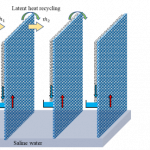
The scarcity of freshwater is a pressing global concern. According to the World Health Organization (WHO), nearly one-third of the world’s population is grappling with severe shortage of drinking water. With 97% of water on earth found in oceans, desalination is as a promising option to augment drinking water supplies.
In the last decade, desalination systems powered by renewable energy have spurred substantial interest. Passive solar thermal desalination systems, in particular, provide a low cost and modular option, making them suitable for regions with poor energy infrastructure. Capillary-assisted passive thermal desalination systems are prone to fouling caused by salt accumulation and also have a very low freshwater water productivity rate due to their limited scalability.
In a new study, researchers led by Susmita Dash at the Department of Mechanical Engineering have introduced a thermal desalination system based on siphonage, a phenomenon in which liquid flows from higher elevation to lower elevation using gravity. The siphon technique allows scaling up the system and helps mitigate the issue of salt accumulation.
The researchers propose a composite siphon comprising of a fabric layer and a metallic grooved substrate. The metallic grooved surface acts as an evaporator on which the liquid supplied by the fabric spreads like a thin film. Grooves are also designed and fabricated on the condenser surface for efficient water collection. The rational design of the evaporator and condenser helped to achieve a low air gap of 2 mm, which is the lowest among the current air-gap desalination systems, and enabled high amount of water collection. As a result, the siphon-based desalination system achieved an unprecedented water collection of 6.23 L-2hr-1 when operated with 1000 W/m2 (1 sun illumination) and 3.5 wt% saline water.
The desalination system is scalable as the water production rate increased proportionally with the size of the system. The salt-resistant feature of the desalination system was demonstrated through continuous operation for 120 hours with hypersaline water (six times more saline than seawater). The desalination system can be operated using solar energy or waste heat sources, making it a promising solution for meeting potable water needs in regions with limited energy resources, isolated islands, and disaster-prone areas.






